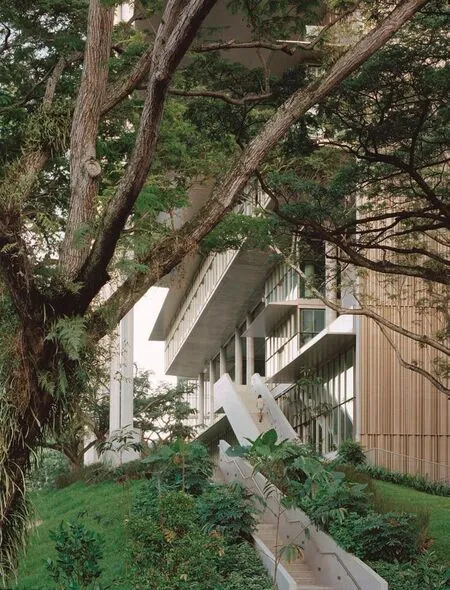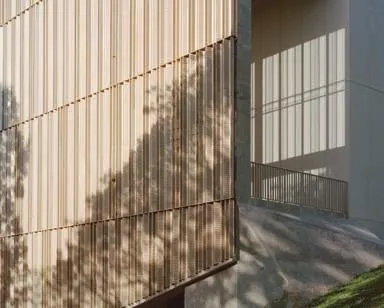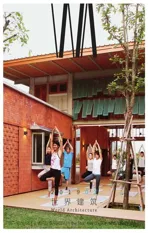新设计与环境学院四教,新加坡国立大学,新加坡
2019-04-19建筑设计克里斯托弗系列建筑事务所
建筑设计:克里斯托弗·李/系列建筑事务所
Design Architect: Christopher Lee/Serie Architects

1 远景/Distant view
在最好的情况下,建筑和设计学院的系馆除了满足其使用者的功能需求之外,还应力图展现和代表学院本身的雄心抱负。这一点,不论是在采用了工业生产逻辑的德绍包豪斯建筑,亦或是哈佛大学设计研究生院为跨学科合作提供的开放工作室平台,又或是建筑联盟学院乔治亚露台学校作为社交中心的酒吧和校友聚会厅,都尤为明显。
从一开始,设计与环境学院显然意图将设计和建成的这座系馆作为教学工具使用,以研究和应对热带气候变化带来的挑战。在这一点上,创建一座零能耗建筑是其设计重点。也就是说,建筑物需要在其建造过程中产生和消耗一样多(甚至更多)的能源。第二个目标则是将建筑作为活体实验室来使用,以学习和测试多种建筑技术,以及建筑对严酷的热带气候的反应。
我们的设计是对东南亚热带本土建筑——马来住宅——文法的一种重新论证。我们从中寻找到巨大的出挑屋顶、可以实现交叉通风的松散的房间布局,以及为了将建筑抬离地面利用平台等原型。因此,我们优先采用巨大的出挑屋顶以避免房间受到阳光直射,与此同时,我们在这个表面上安装1225个PV电池用于发电。
一片开放的社交广场,结合横跨不同工作室和教室的流线体系,旨在促进偶遇和社交互动的机会。随着学习和工作变得越来越具有协作性,再加上本身所具有的社交性,这些空间与系馆内4个主要的学习空间相得益彰。
第一个主要学习空间是一个大型连续的开放工作室空间,用以促进合作和激发学生间对彼此工作的好奇心。第二个主要空间则更有助于沉思,被设计成一系列被景观包围的小房间,供研究员和研究生水平的学生使用。中央的展示空间能够从建筑的各个部分包括设计工作室以不同方式被看到。它垂直地与社交广场连通,使设计讨论成为学习的核心活动。第四个主要学习空间位于东西两侧幕墙之后,用于原型和模型的制作。起伏柔和的多孔铝板既可以缓和东西两侧的强烈阳光,同时保持了其可被拆卸的状态,让学生和研究人员可以在此建筑上测试各种立面系统。

零能耗建筑在文化和技术层面上的重要变革之一在于,如何以最少的能耗为建筑降温。在本项目中这是通过冷却系统与自然通风相结合的混合系统实现的。混合冷却系统利用的是预冷空气(比传统空调降温能耗更低)与吊扇的结合,得到的建筑通透、开放、舒适,同时几乎不需要消耗太多能量。整体而言,该设计是对热带建筑文法的重新验证,融合了新的技术,并考虑到热带地区的能源效率。□
(克里斯托弗·李 文,庞凌波 译)

3 近景/Nearby view
At its best, faculty buildings that house schools of architecture and design - apart from serving functional needs of its occupants - strive to demonstrate and represent the pedagogical ambitions of the school itself. This is evident in the Bauhaus Building in Dessau that adopted the logic of industrial production; the open studio trays for cross-disciplinary collaboration in Harvard GSD;or the bar and front members rooms as a social condenser in the AA's Georgian Terrace School.
From the outset, it was clear that SDE intended to use the design and the completed building as a pedagogical tool for tackling the challenges of climate change in the tropics. Here, the focus was on creating a NET Zero energy building - that is to say,the building generates as much if not more energy that it consumes within its building footprint.The second ambition was to use the building as a living laboratory for learning and testing various technologies and architectural responses to the harsh tropical climate.
Our design is a revalidation of the grammar of vernacular tropical architecture in Southeast Asia,namely that of the Malay House from which we find a large over-sailing roof, the loose accumulation of rooms to allow cross ventilation and the use of platforms to raise the building off the ground. Thus our response was to first employ a large over-sailing roof to protect rooms from the sun and at the same time use this large surface for the installation of 1225 PV cells for energy generation.
An open social plaza together with a circulation system that cuts across the different studios and classrooms is intended to generate chance encounters and foster social interaction. As study and work become increasingly collaborative and thus social in nature, these spaces compliment the four key learning spaces in the school.
The first of these is the large and continuous open studio space designed to foster collaboration and instil curiosity in the work of others. The second is more contemplative in nature, designed as a series of smaller rooms surrounded by landscape to be used by researchers and masters level students. A central presentation space is highly visible from various approaches to the building and the design studios. It drops down to peer into the social plaza making design dialog a central activity of learning. The fourth learning space located behind the east and west curtain walls is intended for proto-typing and model making. Soft undulating perforated aluminium panels moderate the harsh western and eastern sun while remaining demountable to allow students and researchers to test various facade systems on the building itself.
One of the key cultural and technological shifts in this NET Zero energy building is the way the building is cooled with the least amount of energy. This was achieved by using a hybrid system of cooling coupled with natural ventilation. The hybrid cooling uses a combination of tempered air (less energy intensive than conventional AC cooling) with ceiling fans. The resulting architecture is transparent, open, and comfortable, while at the same time requiring very little energy. As a whole the design is a revalidation of the grammar of tropical architecture that fuses new technologies and thinking about energy efficiency in the tropics.□ (Text by Christopher Lee)
项目信息/Credits and Data
主持建筑师/Design Architects: Serie + Multiply Architects设计团队/Design Team: Christopher Lee, Bolam Lee,Martin Jameson, Edouard Bettencourt, Jerome Ng, Onusa Charuwana, Julia Cabanas, Jarrel Goh, Yap Mong Ling, Lee Pei Shyun, Tiffany Yap, Leon Yap
项目管理/Project Architect: Surbana-Jurong Consultants Pte. Ltd.
结构设计/Structural Design: Surbana-Jurong Consultants Pte. Ltd.
SDE学院顾问/Consultants from SDE: Lam Khee Poh (SDE Dean), Heng Chye Kiang (Former SDE Dean), Erik Gerard L'Heureux (Vice Dean), Nirmal Kishnani (Former Vice Dean),Giovanni Cossu (Senior Manager, Dean's Office), Bertrand Lasternas (Energy Manager, Dean's Office)
专家小组/Panelof Experts: Chandra Sekhar, Cheah Kok Ming, Erik Gerard L' Heureux, Kua Harn Wei, Joseph Lim,Lee Siew Eang, Nalanie Mithraratne, Nirmal Kishnani, SHEN Lijun, Tan Beng Kiang, Tan Puay Yok, Tham Kwok Wai
能源与气候顾问/Energy and Climatic Consultant:Transsolar Energietechnik Gmbh
声学顾问/Acoustic Consultant: Acviron Acoustics Consultants Pte. Ltd.
总承建/General Contractor: Kajima Overseas Asia Singapore Pte. Ltd.
基础结构/Foundation: 钢筋混凝土/Reinforced concrete
整体结构/Overall Structure: 钢筋混凝土板和框架/Reinforced concrete slab and framing
屋顶结构/Roof: 钢桁架与细钢柱构成的金属屋顶/Metal roof with steel truss and slender steel columns
场地面积/Site Area: 5044.4m2
总建筑面积/Gross Floor Area: 8588.37m2
景观面积/Landscape Area: 1083.4m2
竣工时间/Completion Time: 2019.01
摄影/Photos: Rory Gardiner

6 开放工作室/Open studio

7 二层平面/First floor plan

8 五层平面/Fourth floor plan

9 评图空间/Forum

10 走廊/Veranda

11 过道/Hallway
评论
宋晔皓:SDE4设计得非常迷人,其中给人印象最深的有3个方面,一个是面向未来的教育理念和建筑的匹配,一个是建筑与气候的适应性关系,另一个则是在一定造价控制下实现零能耗的同时,对设计和完成度的追求。这3点密切交织在一起,让我们体验到了非常灵活的功能分区,将空调和非空调区域完美地限定开,这种划分显然对于实现零能耗目标具有显著的意义。其中非空调区域不仅考虑遮阳和自然通风等,其边界的相对随意性,实际上也非常符合教育的特质。用于东西遮阳的铝合金立面单元的可变性,同样也是遮阳功能和教育功能结合的体现。
维罗妮卡·吴:建筑学与教育学之间的关系是长期以来始终存在的话题。新加坡国立大学设计与环境学院四教以一种包容的方式接纳了这种关系,始于设计理念、形式的基本原理,止于空间的功能和实用性。作为一座零能耗建筑,新馆作为一个活体实验室,反映了该学院成为热带气候变化研究和创新领域的领导者的教育雄心。
在融入当地建筑——尤其是马来房屋的文法的同时,柱廊将其直线形式提升为现代主义和地方语言的对话。不同于传统学校设计,它的空间秩序在平面和分区表露无遗,表现出空间的透明性和活力。楼梯、开放社交广场、评图空间与工作室实验室相互交织,这些要素重新定义了能够激发合作与好奇心的学习空间的语汇。建筑同等地强调着社交与学习空间,试图通过建筑促进教育,并阐明在当代应当如何设计学校建筑。这让我想起了赫茨伯格的话:
“我认为一座学校应当像一座小型城市。一座城市会有小的地方和大的地方,各式隐蔽和半隐蔽的场所、狭长的街景,以及各种形式的活动。当然学生们实际上还没有达到可以进入城市探索城市生活的年纪,但他们应该通过学校去探索生活。因此,你必须在学校里创造尽可能多的情景,使他们能够在学校建筑里经历大千世界。”
(庞凌波 译)

12 屋顶1225个PV电池发电/The installation of 1225 PV cells

13 可拆卸立面/Demountable façade

14 立面外侧/Exterior view of the façade

15 立面内侧/Interior view of the façade
Comments
SONG Yehao: The design of SDE4 is fascinating.There are three most impressive points. One is the architectural parallel with the concept of future-oriented education, the second is the adaptable relationship between architecture and climate, and lastly the pursuit of design and completion of zero energy consumption under certain cost control. These three points are closely interwoven together, allowing us to experience a very flexible functional partition, which perfectly de fi nes the air-conditioned and non-air-conditioned areas, and this partition obviously has great signi fi cance for achieving the goalof zero energy consumption. Not only the nonair-conditioned area considers sun-shading and natural ventilation, the relative randomness of its boundary also responds to the characteristics of education.The variability of aluminum alloy facade units used for East-West shading is also the embodiment of the combination of shading function and educational function. (Translated by CHEN Yuxiao)Veronica Ng: The relationship between architecture and pedagogy has been a longstanding discourse.The New Schoolof Design and Environment 4 in the National University of Singapore have embraced this relationship in an inclusive manner, starting from its design ethos, rationale of the form, to the functions and pragmatism of space. As a NET Zero Energy building, the New School acts as a living lab that reflects its pedagogical aspirations being the protagonist for research and innovation of climate change in the tropics.
While embracing the grammar of vernacular architecture, particularly the Malay house, its rectilinear form elevated by pilotis appears as a dialogue of a modernist and vernacular language.Moving away from traditional school design, its ordering of space is evidenced through its plans and section, illustrating spatial transparency and dynamism. The stairways, the open social plaza, the forum interlaced with studios and labs re-de fi ned the language of learning space that generates collaboration and curiosity in learning. Giving a balanced emphasis on both the social and learning spaces, the building attempts to promote education through architecture and how schools should be designed for the contemporary time. In reminds me of the words on Hertzberger:
"I think a school should be like a small city. In a city you have small places, large places, all sorts of secluded and semi-secluded places, you have vistas and you have all sorts of activities. In effect, these pupils are not yet of an age to go into the city and explore the life of the city but they should explore life through the school, so you must create as many conditions as possible in the school so that they experience the world through the school building."
